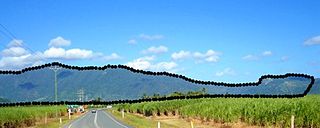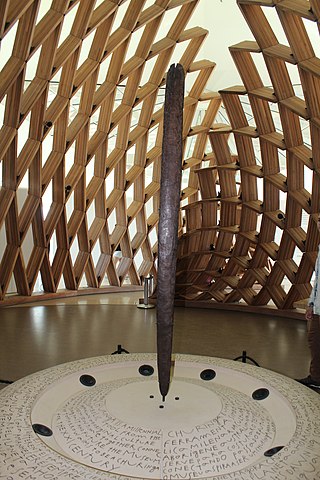
Australian Aboriginal religion and mythology is the sacred spirituality represented in the stories performed by Aboriginal Australians within each of the language groups across Australia in their ceremonies. Aboriginal spirituality includes the Dreamtime, songlines, and Aboriginal oral literature.

The Dreaming, also referred to as Dreamtime, is a term devised by early anthropologists to refer to a religio-cultural worldview attributed to Australian Aboriginal mythology. It was originally used by Francis Gillen, quickly adopted by his colleague Sir Baldwin Spencer and thereafter popularised by A. P. Elkin, who, however, later revised his views.

Sir Walter Baldwin Spencer, commonly referred to as Sir Baldwin Spencer, was a British-Australian evolutionary biologist, anthropologist and ethnologist. He is known for his fieldwork with Aboriginal peoples in Central Australia, contributions to the study of ethnography, and academic collaborations with Frank Gillen. Spencer introduced the study of zoology at the University of Melbourne and held the title of Emeritus Professor until his death in 1929. He was elected a Fellow of the Royal Society in 1900 and knighted in 1916.

Marn Grook, marn-grook or marngrook is the popular collective name for traditional Indigenous Australian football games played at gatherings and celebrations by sometimes more than 100 players. From the Woiwurung language of the Kulin people, it means "ball" and "game".

A Tjurunga, also spelt Churinga and Tjuringa, is an object considered to be of religious significance by Central Australian Aboriginal people of the Arrernte groups. The word derives from the Arrernte word Tywerenge which means sacred or precious. Tjurunga often had a wide and indeterminate native significance. They may be used variously in sacred ceremonies, as bullroarers, in sacred ground paintings, in ceremonial poles, in ceremonial headgear, in sacred chants and in sacred earth mounds.

Francis James Gillen, also known as Frank Gillen and F. J. Gillen, was an early Australian anthropologist and ethnologist. He is known for his work with W. Baldwin Spencer, including their seminal work The Native Tribes of Central Australia (1899). They both worked in central Australia, where Gillen was employed as a telegraph station master, with the Arrernte people and other Indigenous Australians.

Robert Hamilton Mathews (1841–1918) was an Australian surveyor and self-taught anthropologist who studied the Aboriginal cultures of Australia, especially those of Victoria, New South Wales and southern Queensland. He was a member of the Royal Society of New South Wales and a corresponding member of the Anthropological Institute of London.

Frog Dreaming is a 1986 Australian family adventure film written by Everett De Roche and directed by Brian Trenchard-Smith. It starred Henry Thomas, Tony Barry, Rachel Friend and Tamsin West.
Australian Aboriginal culture includes a number of practices and ceremonies centered on a belief in the Dreamtime and other mythology. Reverence and respect for the land and oral traditions are emphasised. The words "law" and "lore", the latter relating to the customs and stories passed down through the generations, are commonly used interchangeably. Learned from childhood, lore dictates the rules on how to interact with the land, kinship and community.

Pas-ta'ai, the "Ritual to the Spirits of the Short [People]", is a ritual of the Saisiyat people, a Taiwanese aboriginal group. The ritual commemorates the Ta'ai, a tribe of short dark-skinned people they say used to live near them. The ritual is held every two years and all Saisiyat are expected to participate.
The Binbinga, also pronounced Binbinka, are an Indigenous Australian people of the Northern Territory of Australia.

Mineng, also spelled Minang or Minanga or Mirnong, are an indigenous Noongar people of southern Western Australia.
The Garrwa people, also spelt Karawa and Garawa, are an Aboriginal Australian people living in the Northern Territory, whose traditional lands extended from east of the McArthur River at Borroloola to Doomadgee and the Nicholson River in Queensland.
The Latjilatji, sometimes spelt Latji Latji or Latje Latje are an Indigenous Australian people of the state of Victoria, Australia.

The Arabana, also known as the Ngarabana, are an Aboriginal Australian people of South Australia.

The Nauo people, also spelt Nawu and Nhawu, are an Aboriginal Australian people of the south-western Eyre Peninsula in South Australia. The Nauo language became extinct by the twentieth century, but efforts are being made to revive it.
The Jingili or Jingulu are an indigenous Australian people of the Northern Territory.

Erlikilyika, known to Europeans by the name Jim Kite or Jim Kyte or Jim Kite Penangke, was an Aboriginal Australian sculptor, artist and anthropological interpreter. He was an Arrernte man, born into the Southern Arrernte or Pertame language group in Central Australia. He was the first Central Australian artist to be nationally recognised for his artistic talent, in particular his carvings of animals in soft stone, illustrations and sculptures, after an exhibition of his work was held in Adelaide, South Australia in 1913.
Patrick Michael Byrne (1856–1932), also known as Paddy or Pado, was an Australian telegraph operator, anthropologist and natural scientist who worked at the remote Charlotte Waters telegraph station in central Australia for 50 years. He was a keen self-taught scientist who collected specimens and corresponded extensively with biologist and anthropologist Walter Baldwin Spencer. He also worked with anthropologist Francis James Gillen at Charlotte Waters, and was a friend of and advocate for the local Arrernte people.















